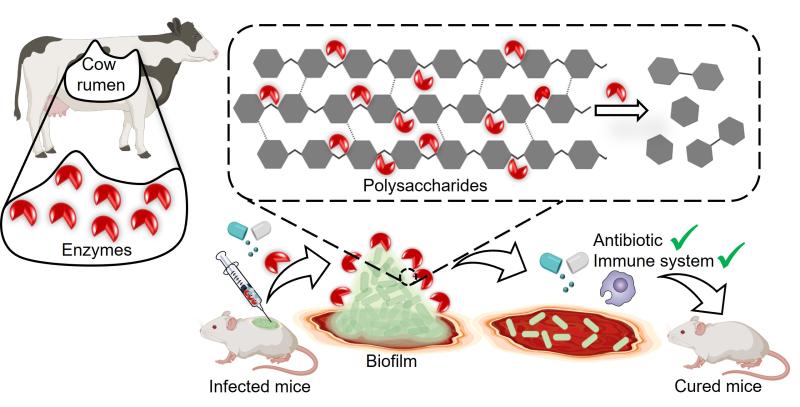
In a new study, scientists at the Indian Institute of Science (IISc) have discovered a method to dismantle the protective biofilms of disease-causing bacteria using an enzyme derived from the digestive tract of cows. This research, published in npj Biofilms and Microbes, offers new hope for treating hospital-acquired infections, particularly those caused by the opportunistic bacterium Klebsiella pneumoniae.
K. pneumoniae is notorious for infecting hospital patients, leading to serious conditions such as pneumonia, urinary tract infections, and meningitis. Particularly alarming is its impact on individuals with diabetes, where infections can result in painful wounds that heal slowly, often necessitating limb amputation.
The strategy developed by the IISc team focuses on breaking down the robust matrix-like biofilms composed mainly of sugars, fats, proteins, and DNA that K. pneumoniae secretes to shield itself from antibiotic treatment. One crucial component of this biofilm is polysaccharides, formed by strings of sugar molecules, which enhance the biofilm’s toughness.
Recognizing the potential of polysaccharide-degrading enzymes, the researchers turned to the bovine gut, known for containing microbial enzymes capable of digesting complex polysaccharides like cellulose and hemicellulose, derived from the animals' plant-based diet. After identifying a promising group of enzymes called glycoside hydrolases (GH), they zoomed in on one particular enzyme, GH-B2, synthesized it in the lab, and tested its effectiveness against four distinct strains of K. pneumoniae isolated from hospital patients.
The results were promising.
“Such broad activity of the enzyme was surprising, as the strains were different in terms of their serotypes,” noted Debasis Das, Assistant Professor in the Department of Inorganic and Physical Chemistry and corresponding author of the study.
K. pneumoniae can vary significantly among strains, with different serotypes eluding the host's immune responses.
When mature biofilms were treated with GH-B2, the biofilm matrix collapsed, rendering the bacteria 15 times more susceptible to the broad-spectrum antibiotic meropenem. More impressively, introducing the enzyme during the early stages of biofilm formation entirely prevented biofilm development, making the bacteria 250 times more vulnerable to the antibiotic. Additionally, the biofilm disruption increased K. pneumoniae’s susceptibility to immune cell attacks from both mice and humans.
Testing in lab mice with K. pneumoniae-infected wounds showed that a combination of GH-B2 and meropenem cleared the biofilms completely.
“The chances of [the bacteria] gaining resistance are very less because our enzyme is not harming the bacteria directly; it is just disrupting the matrix,” remarked Reshma Ramakrishnan, a PhD student in Das’s lab and the study’s first author. “This will be a combinatorial therapy – we can use the enzyme plus the antibiotic for treating K. pneumoniae biofilm-associated infections.”
Looking ahead, the research team aims to incorporate the enzyme into practical applications, like a wound dressing for localized infections, particularly among diabetic patients.
“This can be very promising,” said Dipshikha Chakravortty, Professor at the Department of Microbiology and Cell Biology and another corresponding author of the study.
Furthermore, Das proposed that the enzyme could serve as a coating material on medical devices to inhibit biofilm formation.
“We need to make newer strategies to break the lifestyle of bacteria,” stated Chakravortty, emphasizing the importance of continuously seeking out effective enzymes to combat the rising threat of infectious diseases.
Note: The news story is based on a press release by IISc.






